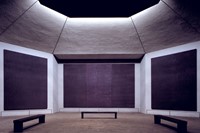This month Alain de Botton published his book Religion for Atheists, and stirred up a storm of controversy of the kind normally reserved for the diatribes of Richard Dawkins. ..
"I am conscious that the phrase "temple for atheists" has had the power to annoy a great many good and clever people – and because my idea is as I conceive it inherently non-contentious, it's clear that I must have explained it extremely badly, for which I'm sorry. Let me start again.
My starting point is that a great many religious buildings are powerful works of architecture: even committed atheists like myself recognise that many cathedrals, mosques, temples and churches are extremely successful and beguiling as buildings. The religious explanation for this power has often invoked God in the creative process. As an atheist, I can't believe in the supernatural explanations for the greatness of religious architecture. I analyse the power in terms of such features as mass, scale, material, sound, air quality and so on.
My suggestion is that contemporary architecture look more closely at the examples of religious architecture, in order to give their buildings some of the qualities that are most appealling in religious buildings; to put it bluntly, in order that these effects not reside only in the cul-de-sac of religious architecture.
Evidently the term 'temple for atheists' has set up uncomfortable associations. People have imagined I might be interested in worshipping an absent deity, or perhaps setting up a cult. Nothing as dramatic or as insane is on the cards. The term was meant playfully, but has been interpreted literally - for which I'm very sorry. I don't care what such places might be called. I'm simply arguing that contemporary architecture analyses the high points of religious architecture throughout history - and that we should allow a new generation of architects to tread in the footsteps of great secular creatives indebted to the ecclesiastical."
"I am conscious that the phrase 'temple for atheists' has had the power to annoy a great many good and clever people – and because my idea is as I conceive it inherently non-contentious, it's clear that I must have explained it extremely badly, for which I'm sorry."
Earlier this month Alain de Botton published his book Religion for Atheists, and stirred up a storm of controversy of the kind normally reserved for the diatribes of Richard Dawkins. The work considers some of the social trappings of religion, and how they could be resituated within an atheistic context, such as temples designed to aid the contemplation of the world through a space that changes one's perspective. As the red mist dissipates and passions subside, here de Botton explains away the misunderstandings that haunted his earlier statements, and lays out his ideas with renewed clarity.
See examples of architecture that have inspired de Botton below.
Text by Tish Wrigley



